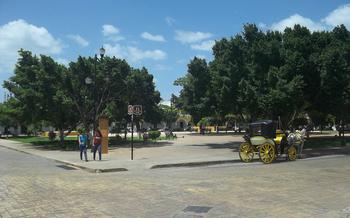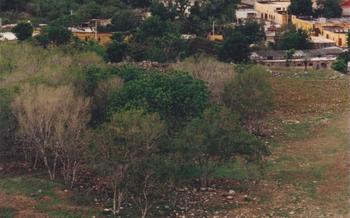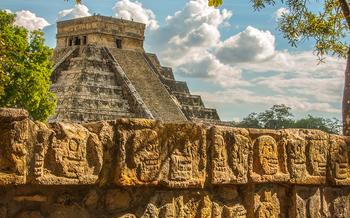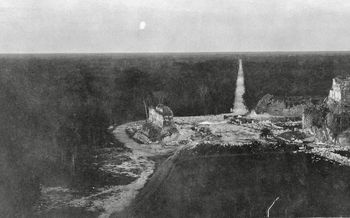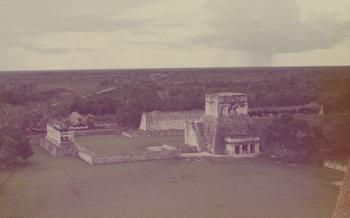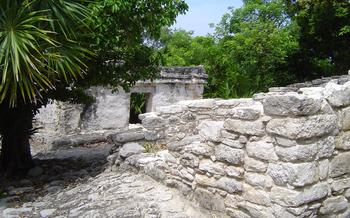
Cenote Xux Ha (Nearby city)
- Cenote Xux Ha: A Sacred Mayan Waterway
- Geological Formation
- Water Quality and Clarity
- Exploring the Cenote
- Sunbathing and Relaxation
- Flora and Fauna
- Cultural Significance
- Photography and Social Media
- Accommodation Options
- Getting There and Transportation
- Budget and Costs:
- Responsible Tourism
- Insider Tip: Unveiling Hidden Gems and Local Experiences
Cenote Xux Ha: A Sacred Mayan Waterway
Cenote Xux Ha, a natural wonder located near the enchanting city of Izamal, holds immense significance for the Mayan people. This awe-inspiring cenote was considered a gateway to the underworld, a place of communication with the gods, and a source of life-giving water. The Mayans revered cenotes as sacred sites, believing that they possessed mystical powers and were connected to the afterlife. Archaeological discoveries at the cenote have revealed ancient Mayan artifacts, including pottery, jewelry, and human remains, offering a glimpse into their rituals and beliefs. Legends and myths associated with Cenote Xux Ha speak of its mystical allure, enchanting visitors with tales of hidden treasures, divine encounters, and the mysterious allure of the underworld.
Geological Formation
Cenotes, natural wells or sinkholes found in the Yucatán Peninsula, result from the unique geological processes that shaped the region's landscape. Over millennia, rainwater seeped through the porous limestone bedrock, gradually dissolving it and forming underground cavities. As the water table fluctuates, the roofs of these cavities can collapse, creating spectacular open cenotes like Cenote Xux Ha.
The breathtaking Cenote Xux Ha showcases the intricate geological features typical of these natural wonders. Its crystal-clear water reflects the surrounding rock formations, displaying a kaleidoscope of colors and textures. The limestone walls are adorned with stalactites and stalagmites, formed by the slow deposition of calcite over thousands of years. These geological wonders, combined with the cenote's crystal-clear water, create a breathtaking spectacle that captivates visitors.
The location of Cenote Xux Ha, nestled within a lush tropical forest, further enhances its geological significance. The cenote's proximity to the surface and the surrounding vegetation contribute to its unique ecosystem. The cenote's water serves as a vital source of freshwater for the local flora and fauna, creating a harmonious relationship between the geological formation and the surrounding environment.
Water Quality and Clarity
The Cenote Xux Ha is renowned for its crystal-clear waters, which offer exceptional visibility for swimming, diving, and snorkeling. The water's clarity is attributed to several factors. First, the cenote is fed by a natural filtration system of underground rivers and aquifers, which removes impurities and sediment. Second, the cenote's depth, reaching over 60 meters in some areas, prevents sunlight from penetrating the water column, limiting the growth of algae and other organisms that can cloud the water. Third, the cenote's location within a protected natural area ensures minimal human impact and pollution.
Preserving the cenote's pristine condition is of utmost importance. Visitors are encouraged to follow sustainable practices, such as avoiding the use of sunscreens and insect repellents containing chemicals that can harm the water's ecosystem. Proper disposal of waste and respecting designated swimming and diving areas also contribute to the conservation of this natural wonder. By adhering to responsible practices, visitors can help ensure the cenote's water quality and clarity for future generations to enjoy.
Exploring the Cenote
Planning a visit to Cenote Xux Ha requires some preparation to ensure a safe and enjoyable experience. It is advisable to plan your trip during the off-season or on weekdays to avoid crowds and fully immerse yourself in the cenote's tranquil atmosphere.
Before entering the cenote, take a moment to familiarize yourself with the layout and safety guidelines. Maps and signage are usually available to guide your exploration. The cenote's underground chambers are connected by tunnels and passageways, so it is crucial to be aware of your surroundings and maintain a sense of direction.
To navigate safely, use a waterproof flashlight or headlamp to illuminate your path. The water in the cenote is generally clear, allowing for good visibility, but it is essential to be cautious of submerged rocks or obstacles. If you are unsure or have concerns, consider hiring a local guide who can provide assistance and ensure your safety during your exploration.
Sunbathing and Relaxation
Surrounded by lush vegetation and the tranquil sounds of nature, Cenote Xux Ha offers a serene escape for sunbathing and relaxation. Secluded spots dot the cenote's perimeter, inviting visitors to bask in the warm sunshine and soak up the beauty of their surroundings. Hammocks strung between trees provide the perfect sanctuary for ultimate relaxation, allowing visitors to sway gently and let their worries melt away. The tranquil atmosphere and natural beauty of the cenote create an ambiance that is both invigorating and calming, making it an ideal destination for those seeking a peaceful retreat.
Flora and Fauna
The cenote's crystal-clear waters and diverse ecosystem provide a haven for a variety of flora and fauna. Lush vegetation surrounds the cenote, with towering trees, tropical flowers, and exotic plants adorning the landscape. Visitors can spot colorful tropical birds flitting through the trees, their melodious songs filling the air. Keep an eye out for iguanas basking in the sun, and listen for the gentle rustling of leaves as small mammals scamper through the undergrowth.
Venturing beneath the surface of the cenote, snorkelers and divers are greeted by a vibrant underwater world. The cenote's crystal-clear waters offer exceptional visibility, allowing visitors to observe the diverse marine life that calls this place home. Schools of colorful fish dart through the water, while larger species such as turtles and stingrays glide gracefully by. The cenote's unique rock formations provide shelter for a variety of aquatic creatures, including crabs, shrimp, and eels.
It is important to remember that the cenote's ecosystem is fragile and must be protected. Visitors should avoid touching or disturbing the wildlife, and refrain from using any chemicals or sunscreens that could harm the delicate balance of the ecosystem. By following these guidelines, we can ensure that the cenote's natural beauty and biodiversity are preserved for generations to come.
Cultural Significance
To the local Mayan community, the Cenote Xux Ha holds profound cultural and spiritual significance. For centuries, the cenote has been a sacred site where rituals and ceremonies are performed. Mayans believe that the cenote is a portal to the underworld, a place of communication with their ancestors. Offerings and prayers are made to honor the gods and seek guidance and protection. It is vital to respect local customs and traditions while visiting the cenote. Visitors should refrain from disturbing any rituals or ceremonies and seek permission before entering the cenote's sacred spaces. By respecting local beliefs and practices, you can contribute to preserving the cultural heritage of this unique site.
Photography and Social Media
Cenote Xux Ha's captivating beauty and Instagram-worthy allure make it a photographer's paradise. Capture stunning shots of the crystal-clear waters, the surrounding lush vegetation, and the unique rock formations. Whether you're a seasoned photographer or simply looking to document your adventure, there are endless opportunities to create memorable content.
Tips for Stunning Cenote Photography:
-
Utilize Natural Light: The best time to photograph the cenote is during the golden hours of sunrise and sunset when the light is soft and diffused, creating a magical atmosphere.
-
Play with Angles: Experiment with different angles to capture the cenote's depth and grandeur. Shoot from above using a drone for a bird's-eye view or get up close and personal with underwater shots.
-
Focus on Details: Don't just capture the big picture; zoom in on the intricate details like the stalactites and stalagmites, the rippling water surface, or the colorful aquatic life.
-
Use a Waterproof Camera or Housing: If you plan to take underwater shots, ensure you have the proper equipment to protect your camera from water damage.
Responsible Social Media Practices:
-
Geotagging and Hashtags: Use relevant geotags and hashtags when sharing your photos on social media to help others discover this hidden gem.
-
Promote Sustainable Tourism: Use your platform to raise awareness about responsible tourism practices, encouraging your followers to respect the environment and support local communities.
-
Educate and Inspire: Share information about the cenote's cultural significance and the importance of preserving its natural beauty for future generations.
Accommodation Options
When planning your trip to Cenote Xux Ha, you'll find a range of accommodation options to suit different preferences and budgets. Whether you seek comfort, affordability, or a unique cultural experience, there are options to cater to your needs.
For those seeking a luxurious stay, several nearby hotels offer amenities such as swimming pools, spas, and fine dining options. These hotels often provide stunning views of the surrounding natural landscapes and are ideal for travelers looking to unwind and indulge.
If you prefer a more budget-friendly option, guesthouses and hostels are available in nearby towns and villages. These accommodations offer basic yet comfortable rooms at affordable rates, making them a great choice for backpackers and budget travelers.
For a truly immersive experience, consider staying in a local homestay or hacienda. These accommodations allow you to connect with the local Mayan community and learn about their culture and traditions. You'll have the opportunity to enjoy home-cooked meals, participate in traditional activities, and gain insights into the daily life of the local people.
When choosing your accommodation, consider factors such as distance from the cenote, amenities offered, and your budget. Booking in advance, especially during peak season, is recommended to secure your preferred option.
Getting There and Transportation
Reaching Cenote Xux Ha is a breeze, with various transportation options available. For budget-conscious travelers, public buses offer a convenient and affordable way to get there. Simply hop on a bus heading towards Izamal and ask the driver to drop you off at the cenote. Taxis are another option, providing a more direct route and flexibility. If you prefer the freedom and convenience of your own vehicle, renting a car is a great choice. Just follow the signs from Izamal, and you'll be there in no time. Organized tours and day trips are also available, often including transportation, entrance fees, and guided tours, making it a hassle-free option for those short on time or who want a more comprehensive experience.
Budget and Costs:
Exploring Cenote Xux Ha comes with affordable costs, catering to travelers with varying budgets. Entrance fees are typically minimal, ranging from 50 to 100 pesos (approximately $50 to $5), making it accessible for budget-conscious travelers. Additional charges may apply for swimming and diving activities, usually around 100 to 200 pesos ($5 to $10) per person. Renting snorkeling or scuba diving equipment can cost around 150 to 300 pesos ($50 to $15) per day.
To save money, consider packing your own snacks and drinks, as food and beverages at the cenote can be slightly overpriced. Opting for public transportation or renting a bike instead of a car can also help cut down on transportation expenses. If you're on a tight budget, look out for discounts and promotions offered by local tour operators or guesthouses. Remember, the true beauty of Cenote Xux Ha lies in its natural wonders, which can be enjoyed without breaking the bank.
Responsible Tourism
Visiting Cenote Xux Ha and other natural wonders requires a mindful approach to tourism. As travelers, we have a responsibility to minimize our impact on the environment and respect the local culture. Here's how you can contribute to responsible tourism at the cenote:
-
Leave No Trace: Avoid littering and dispose of waste properly. Use eco-friendly products like biodegradable sunscreen and insect repellent to protect the water quality and ecosystem.
-
Respect Wildlife: Refrain from touching or disturbing wildlife. Observe animals from a distance and avoid feeding them.
-
Support Local Initiatives: Choose local businesses that support sustainable practices. Consider staying in eco-lodges, booking guided tours with local operators, and purchasing souvenirs from local artisans.
-
Educate Yourself: Learn about the local culture and customs before your visit. Be respectful of local traditions and ask questions if you're unsure about something.
-
Spread Awareness: Share your experiences responsibly on social media and encourage others to practice sustainable tourism. Use hashtags like #ResponsibleTourism and #ProtectOurCenotes to raise awareness.
By following these guidelines, we can help preserve the beauty and tranquility of Cenote Xux Ha for future generations while supporting the local community and protecting the environment.
Insider Tip: Unveiling Hidden Gems and Local Experiences
Beyond the allure of Cenote Xux Ha, the region offers a treasure trove of hidden gems waiting to be discovered. Venture off the beaten path and uncover lesser-known cenotes tucked away in the lush vegetation. Each cenote possesses its own unique charm, from secluded swimming spots to awe-inspiring underwater caverns.
Embrace the opportunity to immerse yourself in the local culture by exploring the surrounding countryside and visiting nearby villages. Engage with the friendly locals, learn about their traditions, and savor the flavors of authentic Mexican cuisine. Homestays and haciendas provide a unique glimpse into the region's rich heritage, offering travelers an immersive experience that goes beyond the tourist trail.
For the adventurous at heart, there are plenty of off-the-beaten-path experiences to be had. Hike through dense jungles, encounter exotic wildlife, and discover ancient Mayan ruins hidden deep within the landscape. Whether you seek tranquility or adventure, the region surrounding Cenote Xux Ha promises an unforgettable journey filled with natural wonders and cultural encounters.
